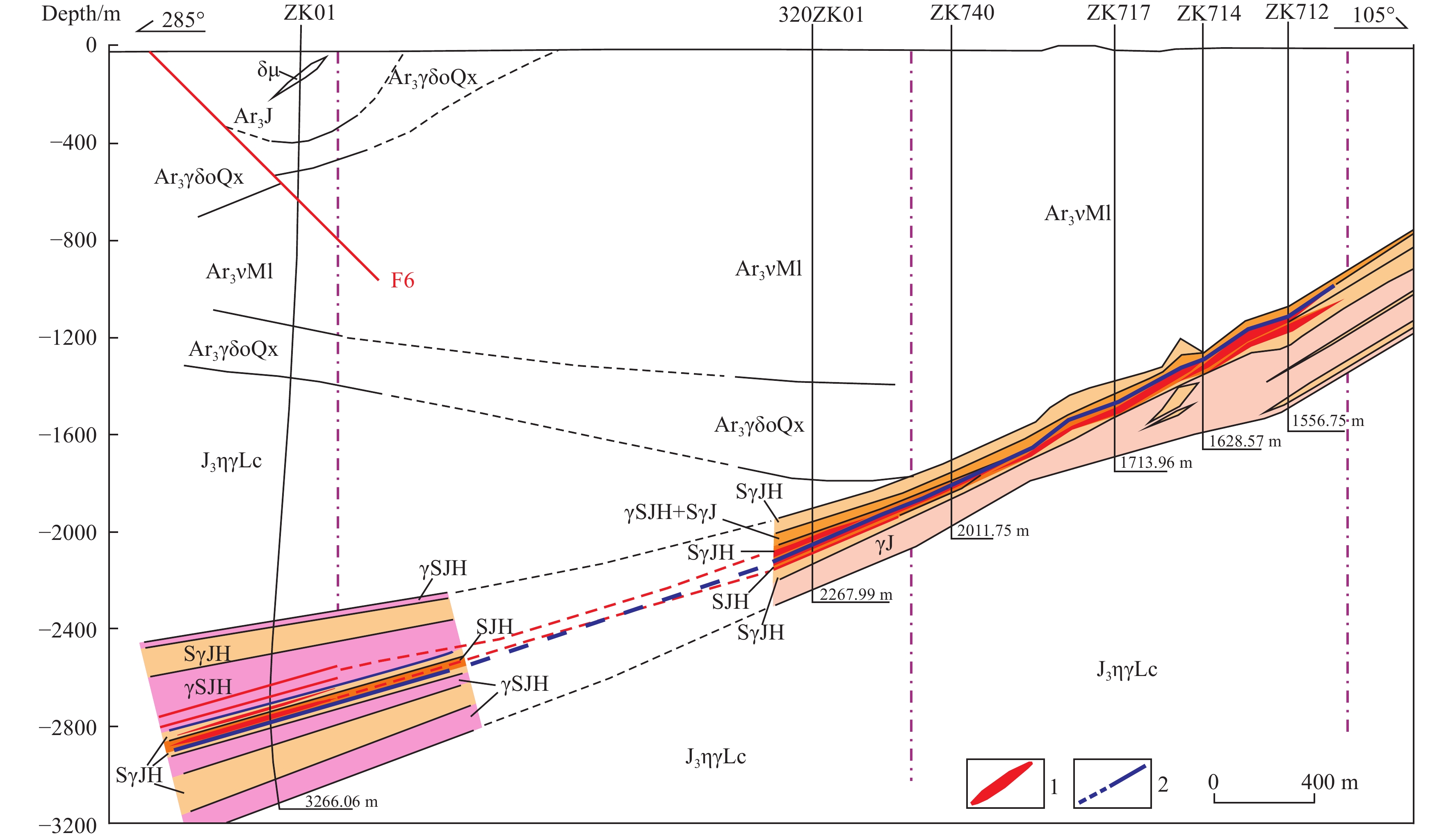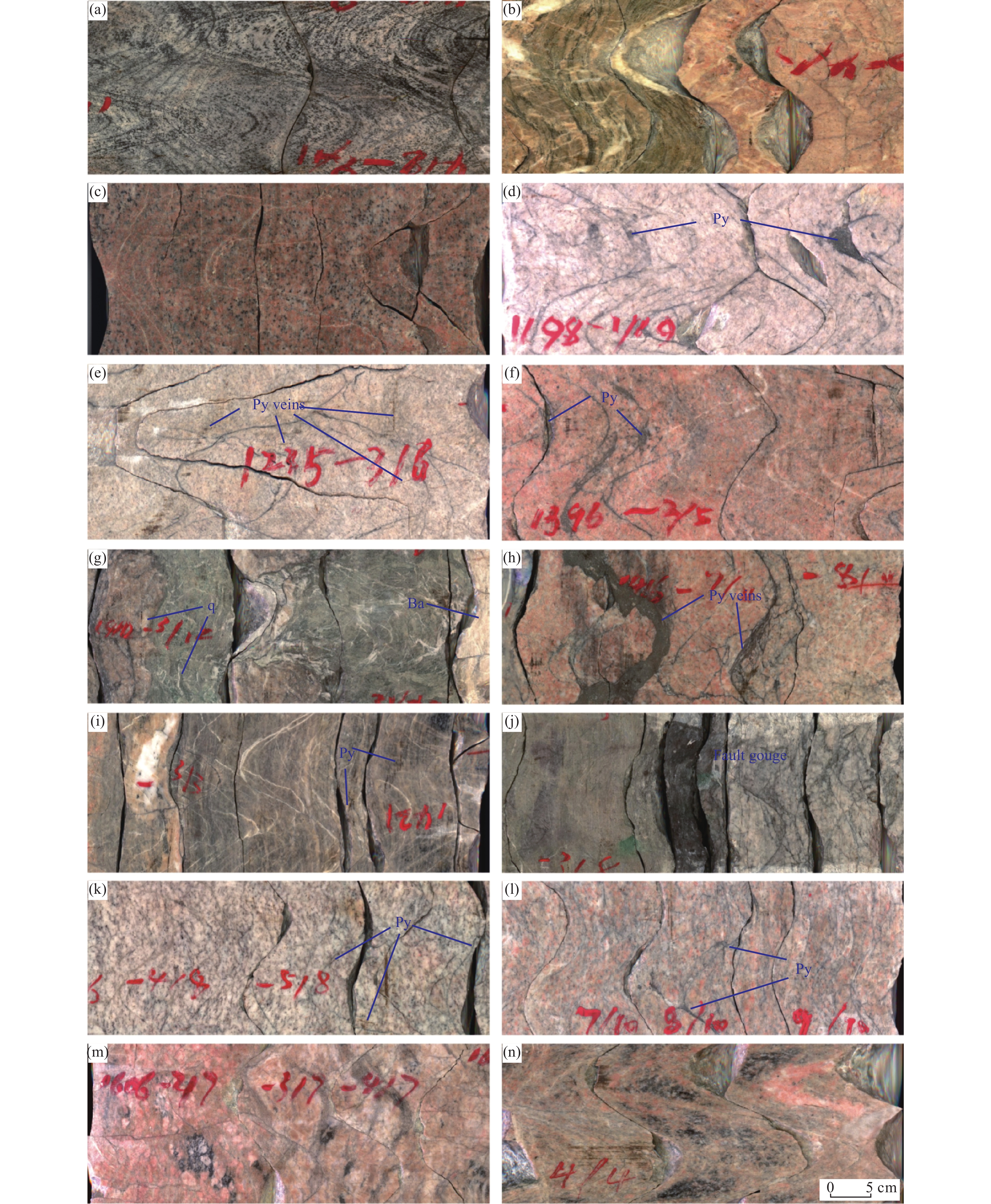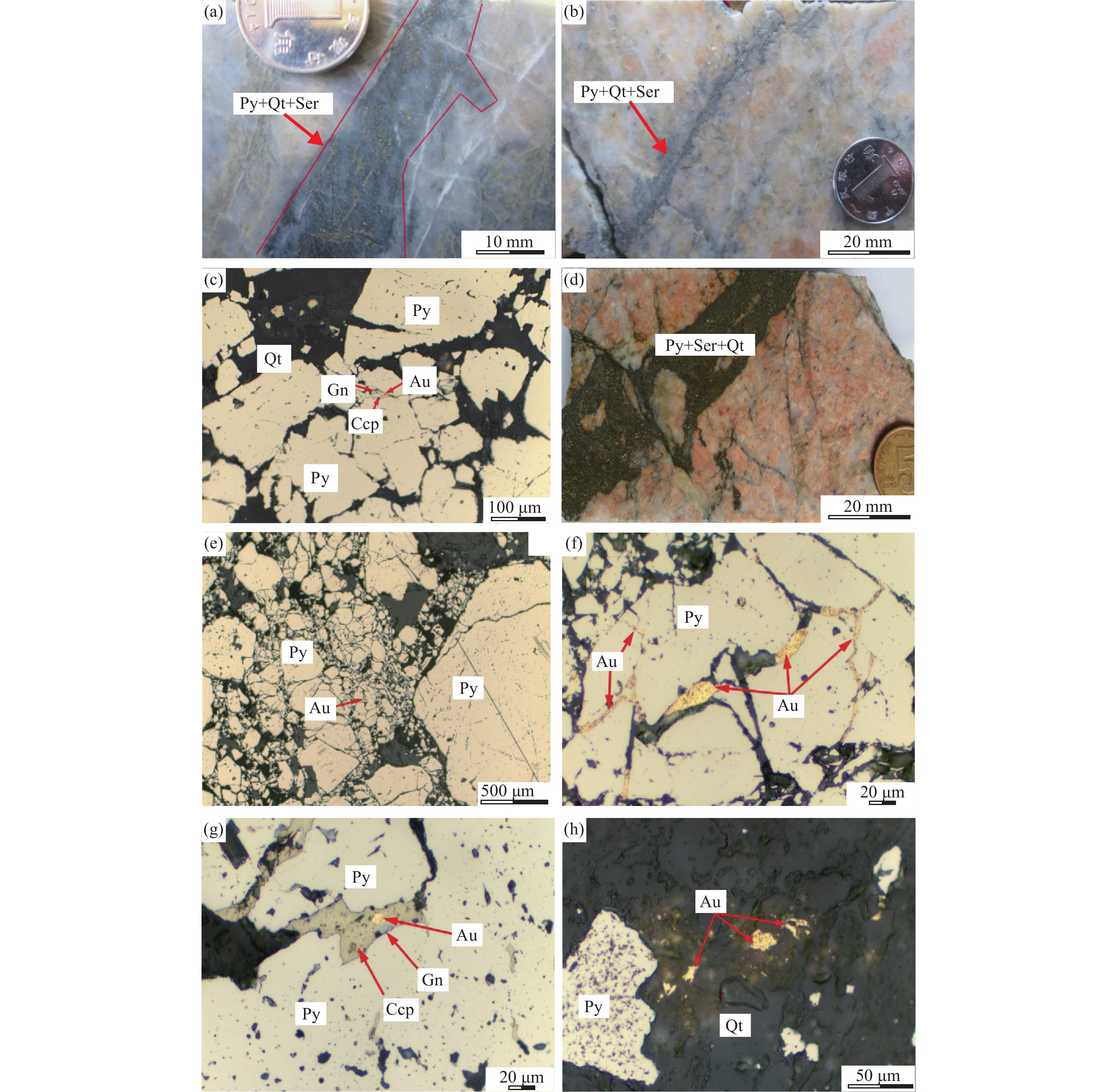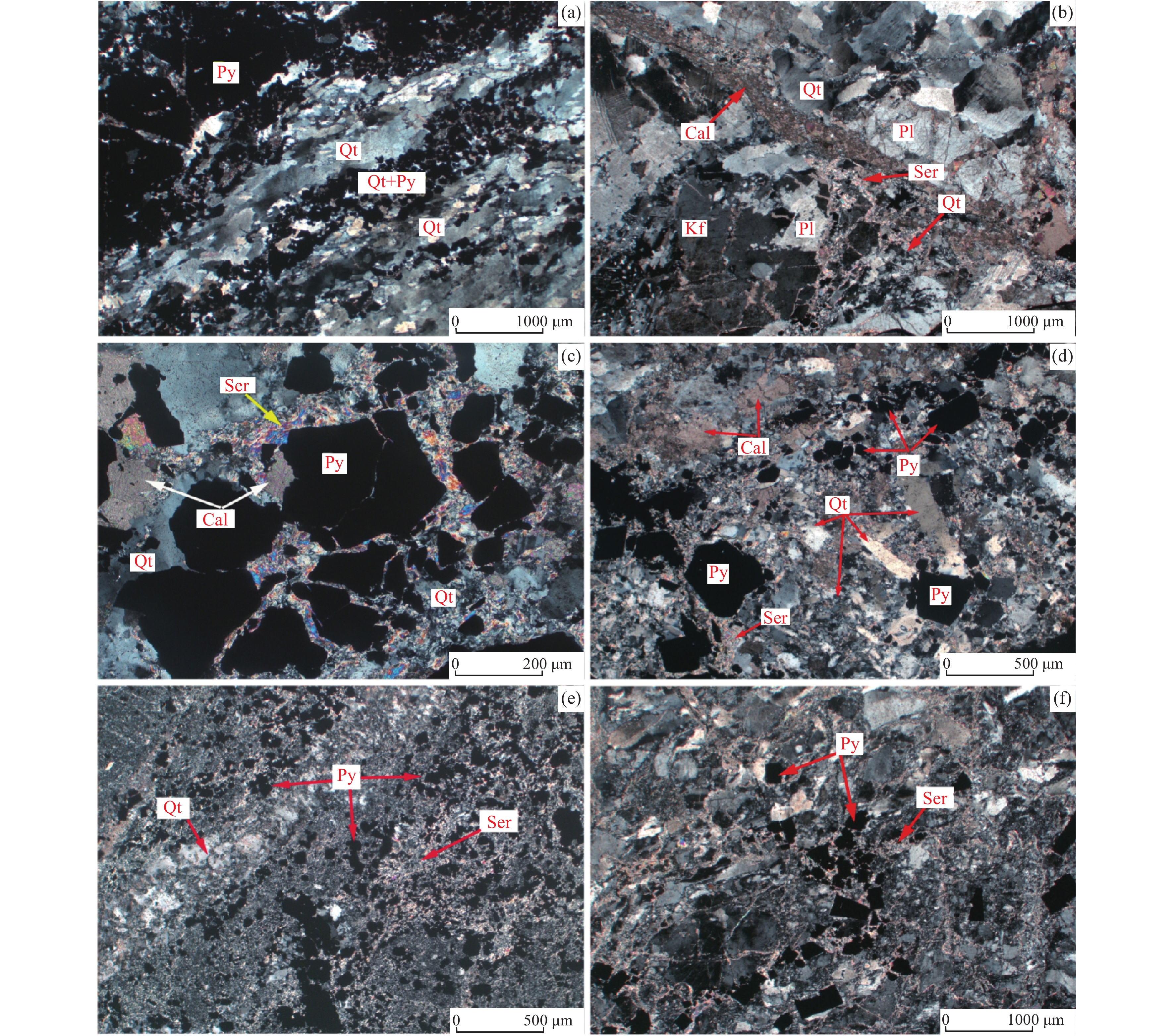| Citation: | Xue-feng Yu, Da-peng Li, Jing-xiang Tian, De-ping Yang, Wei Shan, Ke Geng, Yu-xin Xiong, Nai-jie Chi, Peng-fei Wei, Peng-rui Liu, 2020. Deep gold mineralization features of Jiaojia metallogenic belt, Jiaodong gold Province: Based on the breakthrough of 3000 m exploration drilling, China Geology, 3, 385-401. doi: 10.31035/cg2020048 |
Deep gold mineralization features of Jiaojia metallogenic belt, Jiaodong gold Province: Based on the breakthrough of 3000 m exploration drilling
-
Abstract
Recently, continuous breakthroughs have been made about deep gold prospecting in the Jiaodong gold province area of China. Approximately 5000 t of cumulative gold resources have been explored in Jiaodong, which has thus become an internationally noteworthy gold ore cluster. The gold exploration depth has been increased to about 2000 m from the previous <1000 m. To further explore the mineralization potential of the Jiaodong area at a depth of about 3000 m, the Shandong Institute of Geological Sciences has drilled an exploratory drillhole named “Deep drillhole ZK01” to a depth of 3266 m. Hence, as reported herein, the mineralization characteristics of the Jiaojia metallogenic belt have been successfully documented. ZK01 is, to date, the deepest borehole with an gold intersect in China, and constitutes a significant advance in deep gold prospecting in China. The findings of this study further indicate that the depth interval of 2000 m to 4000 m below the ground surface in the Wuyi Village area incorporates 912 t of inferred gold resources, while the depth interval of 2000 m to 4000 m below the surface across the Jiaodong area possesses about 4000 t of inferred gold resources. The Jiaojia Fault Belt tends to gently dip downward, having dip angles of about 25° and about 20° at vertical depths of 2000 m and 2850 m, respectively. The deep part of the Jiaojia metallogenic belt differs from the shallow and moderately deep parts about fracturing, alteration, mineralization, and tectonic type. The deep zones can generally be categorized from inside outward as cataclastic granite, granitic cataclasite, weakly beresitized granitic cataclasite, beresitized cataclasite, and gouge. These zones exhibit a gradual transitional relation or occur alternately and repeatedly. The mineralization degree of the pyritized cataclastic granite-type ore in the deep part of the Jiaojia metallogenic belt is closely related to the degree of pyrite vein development; that is, the higher the pyrite content, the wider the veins and the higher the gold grade. Compared to the shallow gold ores, the deep-seated gold ores have higher fineness and contain joseite, tetradymite, and native bismuth, suggesting that the deep gold mineralization temperature is higher and that mantle-sourced material may have contributed to this mineralization. ZK01 has also revealed that the deep-seated ore bodies in the Jiaojia metallogenic belt are principally situated above the main fracture plane (gouge) and hosted within the Linglong Granite, contradicting previous findings indicating that the moderately shallow gold ore bodies are usually hosted in the contact zone between the Linglong Granite and Jiaodong Group or meta-gabbro. These new discoveries are particularly significant because they can help correct mineralization prospecting models, determine favorable positions for deep prospecting, and improve metallogenic prediction and resource potential evaluation.
-

-
References
[1] Cai YC, Fan HR, Santosh M, Hu FF, Yang KF, Li XH. 2018. Decratonic gold mineralization: Evidence from the Shangzhuang gold deposit, eastern north china craton. Gondwana Research, 54, 1–22. doi: 10.1016/j.gr.2017.09.009 [2] Chai P, Zhang ZY, Hou ZQ. 2019. Geological and fluid inclusion constraints on gold deposition processes of the Dayingezhuang gold deposit, Jiaodong Peninsula, China. Acta Geologica Sinica (English edition), 93(4), 955–971. doi: 10.1111/1755-6724.13849 [3] Chen YJ, Pirajno F, Lai Y, Li C. 2004. Metallogenic time and tectonic setting of the Jiaodong gold Province, eastern China. Acta Petrologica Sinica, 20, 907–922 (in Chinese with English abstract). [4] Deng J, Wang CM, Bagas L, Carranza EJM, Lu YJ. 2015. Cretaceous-Cenozoic tectonic history of the Jiaojia Fault and gold mineralization in the Jiaodong Peninsula, China: Constraints from zircon U-Pb, illite K-Ar, and apatite fission track thermochronometry. Mineralium Deposita, 50, 987–1006. doi: 10.1007/s00126-015-0584-1 [5] Deng J, Xu SL, Fang Y, Zhou XQ, Wan L. 1996. Tectonic system and metallogenic dynamics in northwestern Jiaodong. Beijing, Geological Publishing House, 1–98 (in Chinese with English abstract). [6] Deng J, Yang LQ, Ge LS, Wang QF, Zhang J, Gao BF, Zhou YH, Jiang SQ. 2006. Study on the Structural System of Jiaodong mining concentration Area. Progress in Natural Science, 16, 513–517. [7] Ding ZJ, Sun FY, Li GH, Ji P, Kong Y. 2015. Accurate zircon U-Pb dating of Early Yanshanian molybdenum-tungsten mother rocks in Xingjiashan area of Jiaodong Peninsula and its significance. Geology in China, 42(2), 556–569 (in Chinese with English abstract). [8] Dou JZ, Zhang HF, Tong Y, Wang F, Chen FK, Li SR. 2018. Application of geothermo-barometers to mesozoic granitoids in the Jiaodong Peninsula, eastern China: Criteria for selecting methods of pressure estimation and implications for crustal exhumation. Journal of Asian Earth Sciences, 160, 271–286. doi: 10.1016/j.jseaes.2018.01.019 [9] Editorial Department of China Geology. 2018. China has launched a deep gold prospecting demonstration project to evaluate gold resource potential within 3000 m underground in the east of the North China Craton. China Geology, 1, 572–573. doi: 10.31035/cg2018047 [10] Fan HR, Feng K, Li XH, Hu FF, Yang KF. 2016. Mesozoic gold mineralization in the Jiaodong and Korean peninsulas. Acta Petrologica Sinica, 10, 3225–3238 (in Chinese with English abstract). [11] Fan HR, Hu FF, Yang JH, Shen K, Zhai MG. 2005. Fluid evolution and large-scale gold metallogeny during Mesozoic tectonic transition in the eastern Shandong Province. Acta Petrologica Sinica, 21, 1317–1328 (in Chinese with English abstract). [12] Goldfarb RJ, Groves DI, Gardoll S. 2001. Orogenic gold and geologic time: A global synthesis. Ore Geology Reviews, 18, 1–75. doi: 10.1016/S0169-1368(01)00016-6 [13] Goldfarb RJ, Santosh M. 2014. The dilemma of the Jiaodong gold deposits: Are they unique? Geoscience Frontiers, 5, 139–153. doi: 10.1016/j.gsf.2013.11.001 [14] Goldfarb RJ, Taylor RD, Collins GS, Goryachev NA, Orlandini OF. 2014. Phanerozoic continental growth and gold metallogeny of Asia. Gondwana Research, 25, 48–102. doi: 10.1016/j.gr.2013.03.002 [15] Groves DI, Goldfarb RJ, Gebre-Mariam M, Hagemann SG, Robert F. 1998. Orogenic gold deposits: A proposed classification in the context of their crustal distribution and relationship to other gold deposit types. Ore Geology Reviews, 13, 7–27. doi: 10.1016/S0169-1368(97)00012-7 [16] Guo LN, Marsh E, Goldfarb RJ, Wang ZL, Li RH, Chen BH, Li JL. 2016. A comparison of Jiaojia- and Linglong-type gold deposit ore-forming fluids: Do they differ? Ore Geology Reviews, 88, 511–533. doi: 10.1016/j.oregeorev.2016.12.003 [17] Han ZY, Yu XW, Li SJ, Tian JX, Wang ZL, Yu XJ, Wang LG. 2019. He-Ar isotopic tracing of pyrite from ore-forming fluids of the Sanshandao Au deposit, Jiaodong Area. Acta Geologica Sinica (English edition), 93(6), 1797–1807. doi: 10.1111/1755-6724.14335 [18] Hao ZG, Fei HC, Hao QQ, Liu L. 2016. Two super-large gold deposits have been discovered in Jiaodong Peninsula of China. Acta Geologica Sinica (English edition), 90(1), 368–369. doi: 10.1111/1755-6724.12660 [19] Henley RW. 1973. Solubility of gold in hydrothermal chloride solutions. Chemical Geology, 11, 73–87. doi: 10.1016/0009-2541(73)90044-2 [20] Hou ML, Jiang YH, Jiang SY, Ling HF, Zhao KD. 2007. Contrasting origins of late Mesozoic adakitic granitoids from the northwestern Jiaodong Peninsula, East China: Implications for crustal thickening to delamination. Geological Magazine, 144, 619–631. doi: 10.1017/S0016756807003494 [21] Jiang SY, Dai BZ, Jiang YH, Zhao HX, Hou ML. 2009. Jiaodong and Xiaoqinling: Two orogenic gold provinces formed in different tectonic settings. Acta Petrologica Sinica, 25, 2727–2738 (in Chinese with English abstract). [22] Jiang XH, Fan HR, Hu FF, Yang KF, Lan TG, Zheng XL, Jin NX. 2011. Comparative studies on fluid inclusionin different depths and oregenesis of the Sanshandao gold deposit, Jiaodong Peninsula. Acta Petrologica Sinica, 27, 1327–1347 (in Chinese with English abstract). [23] Kerrich R, Goldfarb RJ, Groves, DI, Steven G, Jia YF. 2000. The characteristics, origins, and geodynamic settings of supergiant gold metallogenic provinces. Science in China (Series D), 43, 1–68. [24] Kyle PR, Seward D. 1984. Dispersed rhyolitic tephra from New Zealand in deep-sea sediments of the Southern Ocean. Geology, 12, 487–490. doi: 10.1130/0091-7613(1984)12<487:DRTFNZ>2.0.CO;2 [25] Li HM, Shen YC, Liu TB. 2002. Genetic relationship between Jiaojia-type and Linglong-type gold deposits in northwesrern Jiaodong district, Shandong Province. Mineral Deposits, 21, 621–624 (in Chinese with English abstract). [26] Li J, Song MC, Li SY, Zhou XJ, Song YX, Ding ZJ, Yang LX, Wang SS, Jiang F, Li Q. 2016. Geological and geochemical features of the Dadengge gold polymetallic deposit in Jiaodong Peninsula. Geology in China, 43(1), 221–237 (in Chinese with English abstract). [27] Li J, Song MC, Liang JL, Jiang MY, Li SY, Ding ZJ, Su F. 2020a. Source of ore-forming fluids of the Jiaojia deeplyseated gold deposit: Evidences from trace elements and sulfur-helium-argon isotopes of pyrite. Acta Petrologica Sinica, 36(1), 297–313 (in Chinese with English abstract). doi: 10.18654/1000-0569/2020.01.23 [28] Li J, Zhang LP, Li CY, Jiang MY. 2020b. Rb-Sr age of pyrite in Guocheng gold deposit, Jiaodong. Geology in China, http://kns.cnki.net/kcms/detail/11.1167.P.20191204.1000.002.html (in Chinese with English abstract). [29] Li JJ, Luo ZK, Liu XY, Xu WD, Luo H. 2005. Geodynamic setting for formation of large-superlarge gold deposits and Mesozoic granites in Jiaodong area. Mineral Deposits, 24, 361–372 (in Chinese with English abstract). [30] Li Q, Song H, Zhang GY, Yan WQ, Nie R, Si F, Yao C, Zhao ZC, Li W. 2019. Why the temperature parameters of mineralization are similar in the Jiaodong gold deposits: An inference from geothermal gradients. Acta Geologica Sinica (English edition), 93(supp.2), 104–105. [31] Li SR, Santosh M. 2014. Metallogeny and craton destruction: Records from the North China Craton. Ore Geology Reviews, 56, 376–414. doi: 10.1016/j.oregeorev.2013.03.002 [32] Liu C, Deng JF, Li SR, Xiao QH, Jin TJ, Sun H, Di YJ, Liu Y, Zhao GC. 2018. Discussions on crust-mantle structure during the formation of Yanshanian of large-super large scale deposits in the Jiaodong Gold Ore District: Constraints from ore-forming igneous assemblage. Earth Science Frontiers, 25(6), 296–307 (in Chinese with English abstract). doi: 10.13745/j.esf.sf.2018.11.16 [33] Liu XD, Deng J, Zhang L, Lin SY, Zhou ML, Song YZ, Xu XL, Lian CQ. 2019. Hydrothermal alteration of the Sizhuang gold deposit, northwestern Jiaodong Peninsula, eastern China. Acta Petrologica Sinica, 35(5), 1551–1565 (in Chinese with English abstract). doi: 10.18654/1000-0569/2019.05.15 [34] Ma L, Jiang SY, Albrecht WH, Xu YG. 2016. A possible mechanism to thin lithosphere of the North China Craton: Insights from Cretaceous mafic dikes in the Jiaodong pensinsula. Acta Geologica Sinica (English Edition), 90(supp.1), 106–108. [35] Mao JW, Li HM, Wang YT, Zhang CQ, Wang RT. 2005. The relationship between mantle-derived fluid and gold Ore-formation in the eastern Shandong peninsula: Evidences from D-O-C-S Isotopes. Acta Geologica Sinica, 79, 839–857 (in Chinese with English abstract). [36] Mao JW, Wang YT, Li HM, Pirajno F, Zhang CQ, Wang RT. 2008. The relationship of mantle-derived fluids to gold metallogenesis in the Jiaodong Peninsula: Evidences from D-O-C-H isotope systematics. Ore Geology Reviews, 33, 361–381. doi: 10.1016/j.oregeorev.2007.01.003 [37] Mao XC, Wang MJ, Liu ZK, Chen J, Deng H. 2019. Quantitative analysis of ore-controlling factors based on exploration data of the Dayingezhuang gold deposit in the Jiaodong Peninsula. Earth Science Frontiers, 26(4), 84–93 (in Chinese with English abstract). doi: 10.13745/j.esf.2019.04.010 [38] Miao LC, Luo ZK, Guan K, Huang JZ. 1997. The evolution of the ore-controlling faults in the Zhaoye gold belt, eastern Shandong Province. Contributions to Geology and Mineral Resources Research, 12, 26–35 (in Chinese with English abstract). [39] Phillips RE, Powell JA, Hallwachs W, Janzen, DH. 2014. A synopsis of the genus Ethmia Hübner in Costa Rica: Biology, distribution, and description of 22 new species (Lepidoptera, Gelechioidea, Depressariidae, Ethmiinae), with emphasis on the 42 species known from Área de Conservación Guanacaste. Zookeys, 461, 1–86. doi: 10.3897/zookeys.461.8377 [40] Pirajno F, Santosh M. 2014. Rifting, intraplate magmatism, mineral systems and mantle dynamics in central-east Eurasia: An overview. Ore Geology Reviews, 63, 265–295. doi: 10.1016/j.oregeorev.2014.05.014 [41] Sai SX, Deng J, Qiu KF, Miggins DP, Zhang L. 2020. Textures of auriferous quartz-sulfide veins and 40Ar/39Ar geochronology of the Rushan gold deposit: Implications for processes of ore-fluid infiltration in the eastern Jiaodong gold province, China. Ore Geology Reviews, 117, 1–23. doi: 10.1016/j.oregeorev.2019.103254 [42] Seward D, Tulloch AJ. 1991. Fission-track analysis of Tertiary uplift history of granitic basement in the Victoria Range, West Coast, New Zealand. New Zealand Journal of Geology and Geophysics, 34, 115–120. doi: 10.1080/00288306.1991.9514448 [43] Shan W, Yu XF, Xiong YX, Chi NJ, Sun B, Li DP, Ma XD, Sun YQ, Shu L. 2019. Results and prospects of deep exploration in Jiaodong area. Shandong Land and Resources, 35(7), 88–88 (in Chinese with English abstract). [44] Shenyang Institute of Geology and Mineral Resources. 1988. Collection of Regional Metallogenic Conditions of Main Types of Gold Deposits in China (5. Jiaodong area). Beijing, Geological Publishing House, 1–25 (in Chinese). [45] Song MC, Cui SX, Zhou ML, Jiang HL, Yuan WH, Wei XF, Lu GX. 2010. The deep oversize gold deposit in the Jiaojia field, Shandong province and its enlightenment for the Jiaojia-type gold deposits. Acta Geologica Sinica, 84, 1349–1358 (in Chinese with English abstract). [46] Song MC, Wang SS, Yang LX, Li J, Li SY, Ding ZJ. 2017. Metallogenic epoch of nonferrous metallic and silver deposits in the Jiaodong Peninsula, China and its Geological Significance. Acta Geologica Sinica (English Edition), 91(4), 1305–1325. doi: 10.1111/1755-6724.13363 [47] Song MC, Yi PH, Xu JX, Cui SX, Shen K, Jiang HL, Yuan WH, Wang HJ. 2012. A step metallo-genetic model for gold deposits in the northwestern Shandong Peninsula. China Science: Earth Science, 55, 940–948 (in Chinese with English abstract). doi: 10.1007/s11430-012-4366-7 [48] Wang J, Zhu LX, Ma SM, Tang SX, Zhang LL, Zhou WW. 2019. Application of the multi-attribute anomaly model for prospecting potential at depth: A case study of the Haiyu Au deposit in the Jiaodong Gold Province, China. Journal of Geochemical Exploration, 207, 1–24. doi: 10.1016/j.gexplo.2019.106359 [49] Wang JC, Xia B, Tang JR. 2003. Recognition on some key geological problems of Linglong-Jiaojia ore-concentrated district in Shandong Province. Geotectonica et Metallogenia, 27, 147–151 (in Chinese with English abstract). [50] Wang JH, Tian JX. 2017. The determination of position of the northern extension of Sanshandao fault toward waters and metallogenic prediction. Acta Geologica Sinica, 91(12), 2771–2780 (in Chinese with English abstract). [51] Wang LG, Qiu YM, McNaughton NJ, Groves DI, Luo ZK, Huang JZ, Miao LC, Liu YK. 1998. Constraints on crustal evolution and gold metallogeny in the northwestern Jiaodong Peninsula, China, from SHRIMP U-Pb zircon studies of granitoids. Ore Geology Reviews, 13, 275–291. doi: 10.1016/S0169-1368(97)00022-X [52] Wei Q, Fan HR, Lan TG, Liu X, Jiang XH, Wen BJ. 2015. Genesis of Sizhuang gold deposit, Jiaodong Peninsula: Evidences from fluid inclusion and quartz solubility modeling. Acta Petrologica Sinica, 31, 1049–062 (in Chinese with English abstract). [53] Yang JH, Chu MF, Liu W, Zhai MG. 2003. Geochemistry and petrogenesis of Guojialing granodiorites from the northwestern Jiaodong Peninsula, eastern China. Acta Petrologica Sinica, 19, 692–700 (in Chinese with English abstract). [54] Yang KF, Fan HR, Santosh M, Hu FF, Wilde SA, Lan TG, Lu LN, Liu YS. 2012. Reaction of the Archean lower crust: Implications for zircon geochronology, elemental and Sr-Nd-Hf isotopic geochemistry of Late Mesozoic granitoids from northwestern Jiaodong Terrane, the North China Craton. Lithos, 146–147, 112–127. doi: 10.1016/j.lithos.2012.04.035 [55] Yang LQ, Deng J, Guo RP, Guo LN, Wang ZL, Chen BH, Wang XD. 2016. World-class Xincheng gold deposit: An example from the giant Jiaodong gold province. Geoscience Frontiers, 7(3), 419–430. doi: 10.1016/j.gsf.2015.08.006 [56] Yang LQ, Deng J, Song MC, Yu XF, Wang ZL, Li RH, Wang SR. 2019. Structure control on formation and localization of giant deposits: An example of Jiaodong gold deposits in China. Geotectonica et Metallogenia, 43(3), 431–446 (in Chinese with English abstract). doi: 10.16539/j.ddgzyckx.2019.03.005 [57] Yang LQ, Deng J, Wang ZL, Zhang L, Guo LN, Song MC, Zheng XL. 2014. Mesozoic gold metallogenic system of the Jiaodong gold province, eastern China. Acta Petrologica Sinica, 30, 2447–2467 (in Chinese with English abstract). [58] Yang LQ, Dilek Y, Wang ZL, Weinberg RF, Liu Y. 2018. Late Jurassic, high Ba-Sr Linglong granites in the Jiaodong Peninsula, East China: Lower crustal melting products in the Eastern North China Craton. Geological Magazine, 155(5), 1040–1062. doi: 10.1017/S0016756816001230 [59] Yang LQ, Guo LN, Wang ZL, Zhao RX, Song MC, Zheng XL. 2017. Timing and mechanism of gold mineralization at the Wang’ershan gold deposit, Jiaodong Peninsula, eastern China. Ore Geology Reviews, 88, 491–510. doi: 10.1016/j.oregeorev.2016.06.027 [60] Yang QY, Santosh M, Shen JF, Li S. 2013. Juvenile vs. recycled crust in NE China: Zircon U–Pb geochronology, Hf isotope and an integrated model for Mesozoic goldmineralization in the Jiaodong Peninsula. Gondwana Research, 25, 1445–1468. doi: 10.1016/j.gr.2013.06.003 [61] Yang ZL, Zhang X, Jiang HL. 2007. Geological characteristics of Sizhuang gold deposit in Laizhou City of Shandong Province. Shandong Land and Resources, 23(5), 6–10 (in Chinese with English abstract). [62] Yao XF, Cheng ZZ, Du ZZ. 2019. Zircon U-Pb ages of postore dykes in Xiejiagou gold deposit northwest Jiaodong Peninsula, China and its geological significance. Acta Geologica Sinica (English edition), 93(supp.2), 129. [63] Yu XF, Li DP, Tian JX, Shan W, Li HK, Yang DP, Zhang SK, Luo WQ, Xiong YX. 2018a. Progress of deep exploration and theoretical innovation of metallogenic of gold deposits in Shandong Province. Shandong Land and Resources, 34, 1–13 (in Chinese with English abstract). [64] Yu XF, Shan W, Xiong YX, Geng K, Sun YQ, Chi NJ, Guo BK, Li DP, Li HK, Song YX, Yang DP. 2018b. Deep structural framework and genetic analysis of gold concentration areas in the northwestern Jiaodong peninsula, China: A new understanding based on high-resolution reflective seismic survey. Acta Geologica Sinica (English Edition), 92, 1823–1840. doi: 10.1111/1755-6724.13679 [65] Yu XF, Song MC, Li DP, Tian JX, Wang LM. 2016. Breakthroughs and prospect of gold deposits in Shandong Province. Acta Geologica Sinica (English Edition), 90, 2847–2862. [66] Yu XF, Zhang TZ, Wang H. 2015. Shandong Deposit Mineralization Series. Beijing, Geological Publishing House, 1–644 (in Chinese with English abstract). [67] Zaw K, Meffre S, Lai CK, Burrett C, Santosh M, Graham I, Manaka T, Salam A, Kamvong T, Cromie P. 2014. Tectonics and metallogeny of mainland Southeast Asia— A review and contribution. Gondwana Research, 26, 5–30. doi: 10.1016/j.gr.2013.10.010 [68] Zhai MG, Fan HR, Yang JH, Miao LC. 2004. Intra-continental mineralization of the non-orogenic belt type gold deposit – Jiaodong type gold deposit. Earth Science Frontiers, 11, 85–98 (in Chinese with English abstract). [69] Zhai MG, Santosh M. 2013. Metallogeny of the North China Craton: Link with secular changes in the evolving Earth. Gondwana Research, 24, 275–297. doi: 10.1016/j.gr.2013.02.007 [70] Zhang C. 2015. Tectonic Ore-control Model of Jiaojia Gold Orefield. Beijing, China University of Geosciences (Beijing), Ph.D. dissertation, 1–55 (in Chinese with English abstract). [71] Zhao ZL. 2016. Metallogenesis and Prediction of Jiaojia Gold Deposits, Shandong Province. Beijing, Chinese Academy of Geological Science, Master’s thesis, 1–63 (in Chinese with English abstract). [72] Zhu BL, Liu ZJ, Cheng SB, Xue YS, Wang JP, Xu L. 2016. Re-Os isotopic dating of molybdenites from the Yuangezhuang pluton in Jiaodong and its geological significance. Geology in China, 43(4), 1353–1366 (in Chinese with English abstract). doi: 10.12029/gc20160420 [73] Zhu DC, Zhang W, Wang YP, Tian JX, Liu HD, Hou JH, Gao HL. 2018. Characteristics of ore bodies and prospecting potential of Zhaoxian gold deposit in Laizhou City of Shandong Province. Shandong Land and Resources, 34(9), 14–19 (in Chinese with English abstract). -
Access History

-
Figure 1.
Regional geological sketch of the Jiaodong Peninsula (modified from Yang LQ et al. 2014). HQF–Haiyang-Qingdao Fault; HSF–Haiyang-Shidao Fault; JJF–Jiaojia Fault; MJF–Muping-Jimo Fault; MRF–Muping-Rushan Fault; QXF–Qixia Fault; RCF–Rongcheng Fault; SSDF–Sanshandao Fault; TCF–Taocun Fault; WHF–Weihai Fault; WQYF–Wulian-Qingdao-Yantai Fault; ZPF–Zhaoping Fault.
-
Figure 2.
Section of Jiaojia fractured-alteration belt based on deep drilling. Ar3J–Jiaodong Group plagioclase amphibolite, biotite monzogranite, and biotite-amphibole granulite; Ar3γδοQx–Xinzhuang-Unit tonalitic gneiss of Qixia Sequence; Ar3νMl–Luanjiazhai-Unit of Malianzhuang Sequence; J3ηγ Lc–Cuizhao-Unit biotite adamellite of Linglong Sequence; γJ–phyllic granite; γJH–beresitized granite; γSJH–beresitized cataclastic granite; SγJ–phyllic granitic cataclasite; SγJH–beresitized granitic cataclasite; SJH–beresitized cataclasite; δμ–diorite porphyrite; 1–gold ore body; 2–main fracture plane (gouge).
-
Figure 3.
Scanned photographs showing the ZK01 drillhole core. All photographs were taken using a core scanner and present core surface development. The photograph width is the core perimeter (188.40 mm). All photographs have the same scale. Detailed discription of each layer is given in the text.
-
Figure 4.
Characteristics of ores in the deep part of Jiaojia metallogenic belt. a, b, d−core section; c, e, f, g, h−under microscope. Detailed description of each layer is given in the text. Ccp−Chalcopyrite. Py−Pyrite; Qt−Quartz; Ser−Sericite; Gn−Galena; Au−gold mineral.
-
Figure 5.
Microphotographs showing alteration types. a –pyritization and silification; the quartz is elongated and exhibits sub-granulation viaductile deformation. Quartz-pyrite veins occur along fissures; b–three successive stages of alteration are apparent, i.e., potash alteration with plagioclase replaced by K-feldspar forming residues; networked beresitization; and late-stage carbonate veins cutting through beresite veins; c–beresitization, where pyrite was formed at an early-stage and filled by gold-bearing beresite veins and carbonate veins after fracturing; d–beresitization, where pyrite was formed at a relatively early-stage. Columnar quartz is observable and was carbonatized in the late-stage; e–beresitized cataclasite-type ore (granulitic rock), multi-phased alteration, early-stage beresitization, and late-stage carbonatization; f–beresitized cataclasitetype ore, with beresite veinlets cutting along the rock fissures. Py–pyrite; Qt–Quartz; Ser–Sericite; Cal–Carbonate minerals; Kf–K-feldspar; Pl–Plagioclase (all photographs were taken under cross-polarized light).





 DownLoad:
DownLoad:



